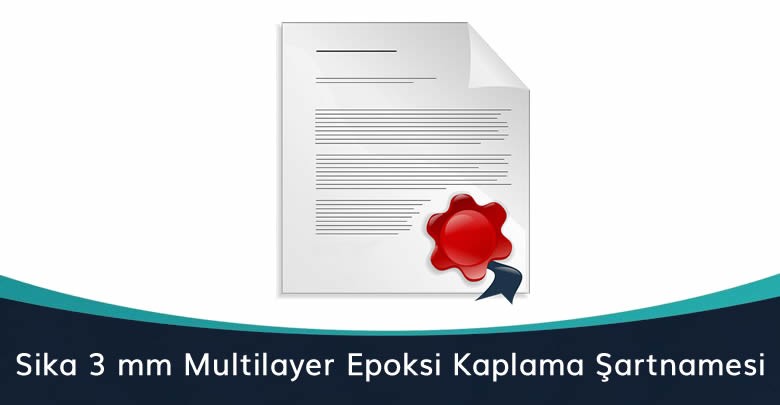Sika 3 mm Multilayer Epoxy Coating Specification

Neler Okuyacaksınız? →
Floor Covering Technical Specifications
(3 mm Multilayer Epoxy Coating)
Download as PDF
1-General
The following job and material definitions describe the material and application to be used in 3 mm multilayer epoxy coating. Reinforced concrete surfaces will be covered with this system. All materials to be used and all works to be done will comply with the criteria specified below. All relevant quality documents will be provided by the manufacturer.
2-Products
Materials used:
Sikafloor 156 (2 component solvent free epoxy primer)
Sikafloor 263 SL (2 component solvent free epoxy coating)
Sikafloor 264 (2 component, solvent free, roller applied topcoat)
The technical specifications of the products should be as follows.
Sikafloor 156
- All tests and test results will be according to the relevant standards stated below. A comparison of the values of another standard and test methods with the following specifications will not be accepted.
- The material is a two-component, low-viscosity, solvent-free epoxy resin.
- Material unit weight (density) Component A 1.10 kg / l
Component B will be 1.02 kg / l.
- Compressive Strength of the material to be used will be Mortar: 95 N / mm².
- Flexural Strength of the material to be used will be Mortar: 30 N / mm 2 .
- The Adhesion Strength of the material to be used will be 1.5 N / mm 2 .
- Shore D Hardness of the material to be used: 83 (7 days / + 23 0 C 50% relative humidity DIN53505)
Sikafloor 263 SL
- The material is a two-component, colored, self level epoxy based coating material.
- Material unit weight (density) A component 1.50 kg / l
B component 1,00 kg / l
- Solid Content Percentage of the material to be used ≈ 100% (by weight), ≈ 100% (by volume).
- Abrasion Resistance of the material to be used 70 mg (7 days / + 23 ° C)
Sikafloor 264
- The material is a two-component, colored, epoxy-based coating material.
- Material unit weight (density) Component A 1.60 kg / l
B component 1,00 kg / l
- Solid Matter Percentage of the material to be used 100 100% (by weight), ≈ 100% (by volume)
- Abrasion Resistance of the material to be used 70 mg (7 days / + 23 ° C)
3- Surface Preparation
- During the application, the surface temperature should be between + 10 ° C and + 30 ° C, and the air temperature should be between + 10 ° C and + 30 ° C.
- The moisture content of the substrate should be 4% by weight (Sika Tramex meter, cm-measurement). There should be no rising humidity according to ASTM. Relative air humidity should not exceed 80%.
- The concrete surface to be manufactured is clean, solid and with sufficient compressive strength, min. 25 N / mm 2 and min. Tensile Strength should be 1.5 N / mm 2 . The surface must be clean, dry and free from foreign materials such as dirt, oil, coating, surface curing materials.
- Concrete surfaces should be removed from cement grout using abrasive equipment and an open porous surface should be obtained.
- Weak concrete should be removed, blowholes and holes should be corrected with suitable ones from “Sikafloor, SikaDur and SikaGard products”.
- The high places on the surface should be abraded, sanded and cleaned. All dust, loose and volatile particles on the application surface should be cleaned with a brush and vacuum cleaner.
4- Preparation of Materials:
- Before applying; A + B components should be mixed for a minimum of 3 minutes until they become homogeneous. Electric mixers with a minimum power of 300-400 rpm should be used for mixing. First component A must be mixed thoroughly in itself. While component A is being mixed, component B is added. The mixed material should be taken into a clean container and mixed again for a short time.
5- Application:
- During the application, the surface temperature should be between + 10 ° C and + 30 ° C, and the air temperature should be between + 10 ° C and + 30 ° C.
- Homogeneously mixed Sikafloor-156 is mixed with quartz sand one to one, and it is applied to the surface with a roller or trowel, and it is applied to close the pores. (SikaFloor 156: 0.5 kg / m 2 + Quartz Sand: 5 kg / m 2 )
- While the primer is still wet, it is blunted by sprinkling quartz sand homogeneously on it. (~ 1.5-2.0 kg / m 2 ). Free sands are cleaned after curing.
- Quartz sand 0.8 kg / m 2 : 0.8 kg / m 2 is added to the mixture of Sikafloor 263 SL (A + B) components . After mixing homogeneously, it is pulled to the surface by scraping with a trowel. Yet this layer onto indurated total 1.00 kg / m 2 consumption silica sand spreader to be discarded.
- Next day; The aggregates that are not fully adhered to the surface are removed from the surface, swept away and the stripping coat application is repeated with a trowel so that the quartz sand 0.5 kg / m²: 0.2 kg / m² is applied to the Sikafloor 263 SL (A + B) mixture.
- The next day, Sikafloor 264 is applied to the entire surface with a top coat layer, squeegee and roller. (Consumption 0,35 kg / m²)
6- Measurement and Payment:
- The amount of work to be done will be determined according to the quantity specified during the tender. However, it will be controlled by the measurement to be made before and after the manufacturing. Payment terms will be determined during the contract phase.